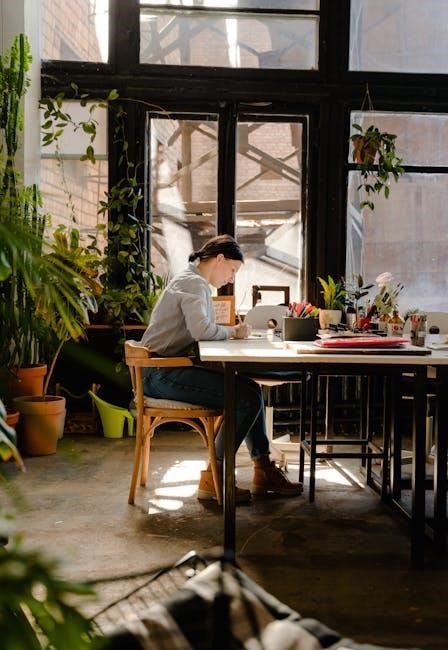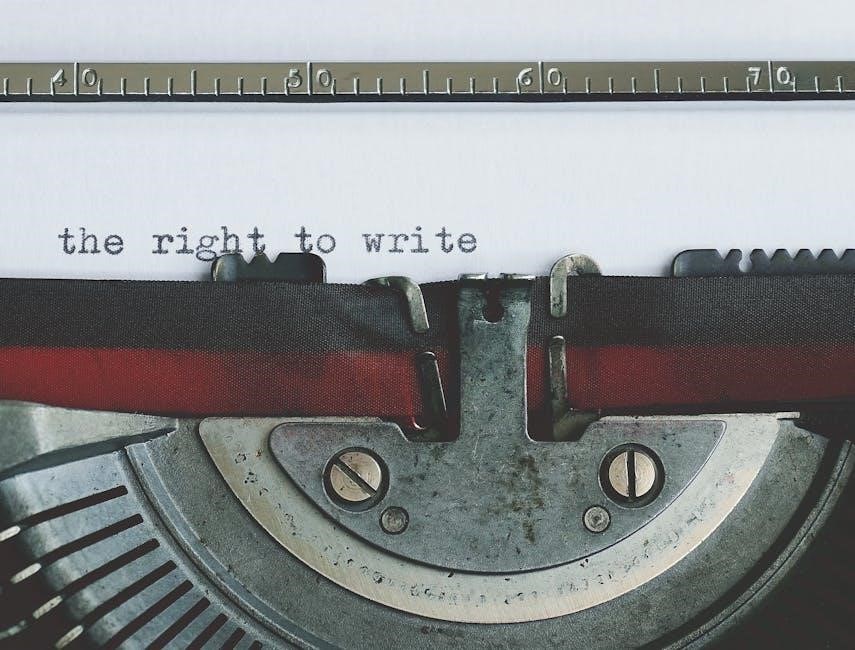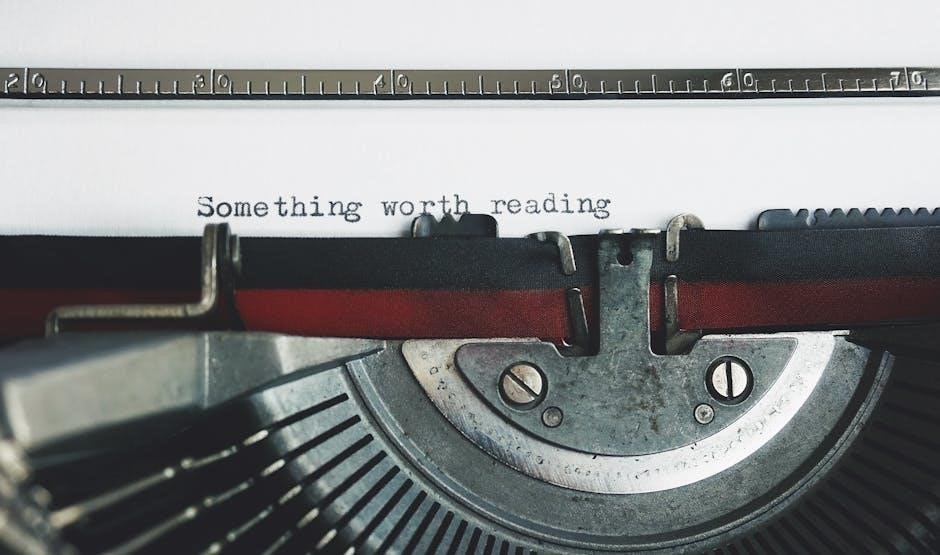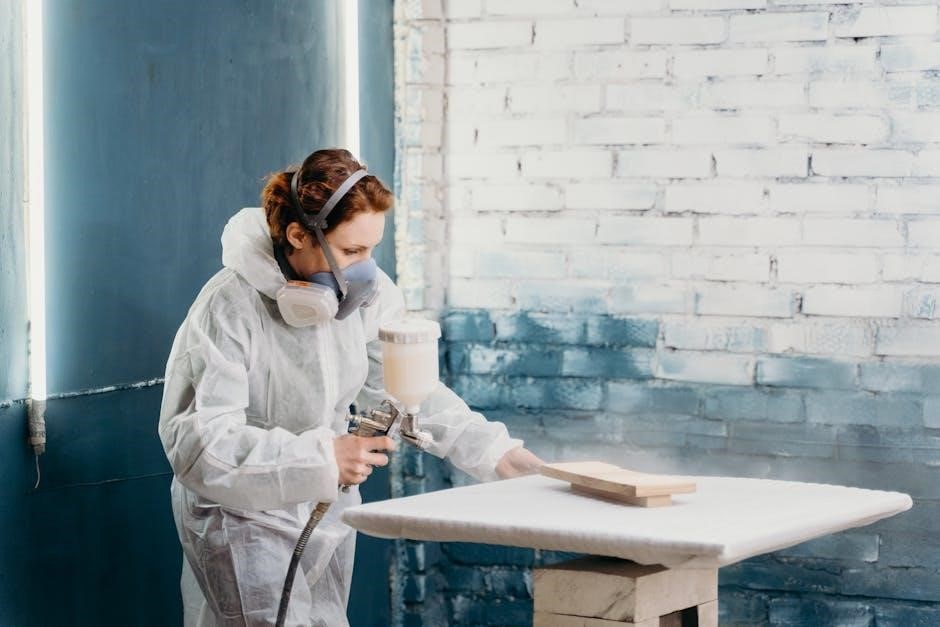manual airbrush

A manual airbrush is a versatile creative tool used for precise painting and detailing. It operates by combining compressed air with paint, allowing for smooth, even coverage. Ideal for artists, modelers, and makeup enthusiasts, it offers control and flexibility in various applications. Proper technique and maintenance are essential for optimal performance.
1.1 What is a Manual Airbrush?
A manual airbrush is a precision painting tool that uses compressed air to atomize paint, creating a smooth, even finish. It requires manual control to regulate airflow and paint flow, offering versatility for detailed work in art, models, and makeup. The device typically includes a reservoir for paint, a nozzle for spray, and a trigger to activate airflow. It is valued for its ability to achieve fine details and subtle gradients, making it essential for various creative applications.
1.2 Basic Components of a Manual Airbrush
A manual airbrush consists of key components that ensure its functionality. The airbrush body houses the internal parts, while the nozzle and needle regulate paint flow and spray pattern. The trigger controls airflow, and the paint reservoir holds the paint. An air hose connects to an air source, providing the pressure needed for atomization. These components work together to deliver precise control over paint application, enabling detailed and smooth finishes in various creative projects.

Types of Manual Airbrushes
Manual airbrushes are categorized into gravity-feed and siphon-feed models. Gravity-feed airbrushes use gravity to deliver paint, ideal for fine details, while siphon-feed airbrushes draw paint from a reservoir, suitable for heavier applications.
2.1 Gravity-Feed Airbrush
A gravity-feed airbrush is a popular choice for its simplicity and precision. It features a paint reservoir located above the needle, allowing gravity to feed the paint into the airflow. This design enables smooth, consistent coverage and is ideal for fine details and small-scale projects. The gravity-feed mechanism reduces the risk of siphoning issues and makes it easier to control paint flow, especially for users who are still learning airbrush techniques.
2.2 Siphon-Feed Airbrush
A siphon-feed airbrush uses a paint reservoir connected to the main chamber via a tube, drawing paint into the airflow through siphon action. This design allows for larger paint capacity and is ideal for covering extensive areas quickly. It is commonly used in automotive and industrial applications, where high-volume painting is required. The siphon-feed mechanism offers versatility but may require higher air pressure for optimal performance, making it suitable for experienced users and heavy-duty projects.

How to Choose the Right Manual Airbrush
Selecting the right manual airbrush involves considering your intended use, paint type, and maintenance preferences. Match the airbrush to your project’s scale and detail requirements for optimal results.
3.1 Factors to Consider
When selecting a manual airbrush, consider paint type compatibility, nozzle size, and airflow control. The intended use and scale of work are crucial. Choose between gravity-feed or siphon-feed based on convenience. Assess durability and ease of maintenance. Consider air pressure requirements and tip precision for detail work. Balance performance with ease of use to ensure the airbrush meets your specific needs and skill level for optimal results.
3.2 Intended Use Cases
Manual airbrushes are widely used in model painting for smooth, even coats and blending. They are ideal for nail art, enabling intricate designs and precise details. In makeup artistry, airbrushes create flawless finishes and special effects. Additionally, they are employed in cake decorating for detailed designs and in graphic design for small-scale projects. Their versatility makes them a valuable tool across various creative fields, offering precision and control for both professionals and hobbyists.
3.3 Paint Type Compatibility
Manual airbrushes can work with various paint types, including acrylic, enamel, and lacquer. Water-based paints are ideal for fine details, while solvent-based paints suit durable finishes. For makeup and cosmetic applications, specialized airbrush paints are recommended. Always ensure the paint is thinned correctly to the airbrush’s specifications for smooth flow. Using incompatible paints can cause clogging or uneven application. Proper cleaning solvents must be used to maintain the airbrush’s performance across different paint types.

Preparing to Use a Manual Airbrush
Preparing a manual airbrush involves cleaning and maintenance. Ensure all parts are assembled correctly and paint is properly thinned for optimal performance and to prevent clogs.
4.1 Cleaning and Maintenance
Cleaning and maintenance are crucial for airbrush longevity. Regularly disassemble and flush with solvent, ensuring no paint residue remains. Use a soft brush to clean internal parts and dry thoroughly. Proper care prevents clogs and ensures smooth operation. Always follow manufacturer guidelines for optimal results and to maintain performance.
4.2 Assembly and Disassembly
Assembling and disassembling a manual airbrush requires care to ensure proper function. Align components precisely during assembly, ensuring no paint residue remains. For disassembly, gently remove parts to avoid damage. Regular cleaning during disassembly prevents clogs and maintains performance. Always handle delicate components with care and follow manufacturer guidelines for reassembly. Proper handling ensures the airbrush operates smoothly and extends its lifespan. Regular maintenance also helps prevent issues during use.
4.3 Drying Techniques
Proper drying techniques are essential for maintaining a manual airbrush. After use, always flush the airbrush with a cleaning solution and compressed air to remove residue. Use a clean, lint-free cloth to wipe exterior surfaces. Avoid direct sunlight or heat, as it can damage components. Store the airbrush in a dry, cool place to prevent moisture buildup. Regularly drying ensures optimal performance and prevents corrosion or clogging. Proper care extends the lifespan and reliability of the airbrush.

Techniques for Using a Manual Airbrush
Mastering airbrush techniques involves controlling air pressure and paint flow. Start with basic spraying, then explore layering, blending, and detailed work for precise results. Practice ensures mastery.
5.1 Basic Spray Techniques
Mastering basic spray techniques is essential for achieving professional results. Start by holding the airbrush at a 90-degree angle to the surface. Maintain a steady hand and consistent air pressure. Practice light, medium, and heavy sprays to control paint flow. Keep the nozzle 6-8 inches away for even coverage. Use smooth, sweeping motions for large areas and precise strokes for details. Regular practice helps develop muscle memory and improves accuracy. These foundational skills are crucial for advanced techniques.
5.2 Advanced Airbrushing Methods
Advanced techniques elevate your airbrushing skills, enabling intricate details and artistic effects. Layering involves building up colors gradually for depth. Blending creates smooth transitions by overlapping wet layers. Stenciling allows for sharp, precise patterns. Experiment with metallic and fluorescent paints for unique finishes. Adjusting air pressure and nozzle size can achieve fine lines or broad coverage. Practice freehand work for organic shapes and textures. These methods, combined with patience and practice, unlock stunning, professional-level results in various artistic and craft projects.
Common Applications of Manual Airbrushes
Manual airbrushes are widely used in model painting for fine details, nail art for intricate designs, and makeup artistry for smooth, even coverage. These tools offer precision and creativity.
6.1 Model Painting
Manual airbrushes are essential for model painting, enabling precise detailing and smooth finishes. They allow for thin, even coats and seamless blending of colors. Ideal for scale models, miniatures, and dioramas, airbrushes save time and enhance realism. Artists use them to achieve intricate designs, weathering effects, and uniform base coats. The ability to control paint flow makes them perfect for small details, ensuring professional-quality results in model painting projects.
6.2 Nail Art
A manual airbrush is a popular tool in nail art, offering precision and creativity for intricate designs. It allows for smooth gradients, ombre effects, and fine details without stamps or stickers. Artists use it to create patterns, layer colors, and achieve uniform coverage. The airbrush is ideal for delicate work, enabling quick and professional results. Suitable for both beginners and professionals, it enhances nail art by providing versatility and control, making it a must-have for modern nail technicians and enthusiasts.
6.3 Makeup Artistry
A manual airbrush is widely used in makeup artistry for achieving smooth, even coverage and intricate designs. It allows for precise application of foundation, contouring, and blending, creating flawless finishes. Artists appreciate its ability to handle various makeup types, from water-based to silicone-based formulas. The airbrush is ideal for special effects, such as tattoos or prosthetics, and is favored for its versatility and control. Whether for everyday looks or high-fashion designs, it remains a essential tool in professional makeup kits, enhancing creativity and precision.

Troubleshooting Common Issues
Common manual airbrush issues include clogging, uneven spray patterns, and air pressure problems. Regular cleaning, proper paint consistency, and adjusting airflow can resolve most difficulties effectively.
7.1 Clogging and Blockages
Clogging and blockages are common issues with manual airbrushes, often caused by dried paint or thick consistency. To resolve this, clean the nozzle with a solvent and use thinners to prepare paint. Regular disassembly and thorough cleaning can prevent clogs. Using the correct needle size and avoiding over-tightening also helps. Frequent maintenance ensures smooth operation and extends the airbrush’s lifespan. Proper storage in a clean, dry environment further prevents blockages.
7;2 Uneven Spray Patterns
Uneven spray patterns can occur due to inconsistent air pressure, clogged nozzles, or improper paint viscosity; To fix this, adjust the airbrush’s pressure setting and clean the nozzle regularly. Ensure the paint is thinned correctly for smooth flow. Holding the airbrush at the right angle and distance is crucial. Practice consistent movement to achieve even coverage. Regular maintenance and proper technique can prevent this issue, ensuring professional-quality results in various applications like model painting or makeup artistry.
7.3 Air Pressure Problems
Air pressure issues can significantly affect the performance of a manual airbrush. Inconsistent or insufficient pressure often leads to uneven spray patterns or poor paint atomization. To resolve this, ensure the air source is stable and adjust the pressure settings according to the task. Check for blockages in the airbrush or hose, as partial clogging can disrupt airflow. Proper maintenance, such as cleaning and lubricating moving parts, can also help maintain consistent air pressure. Regularly inspecting and replacing worn seals or O-rings is essential for optimal performance.
A manual airbrush is a powerful and versatile tool for achieving precise, professional results in various creative fields. Whether for model painting, nail art, or makeup, mastering its use can elevate your work. Proper maintenance, such as cleaning and adjusting air pressure, is key to optimal performance. By understanding its components and techniques, you can unlock its full potential and enjoy consistent, high-quality outcomes in your projects.
Leave a Reply
You must be logged in to post a comment.